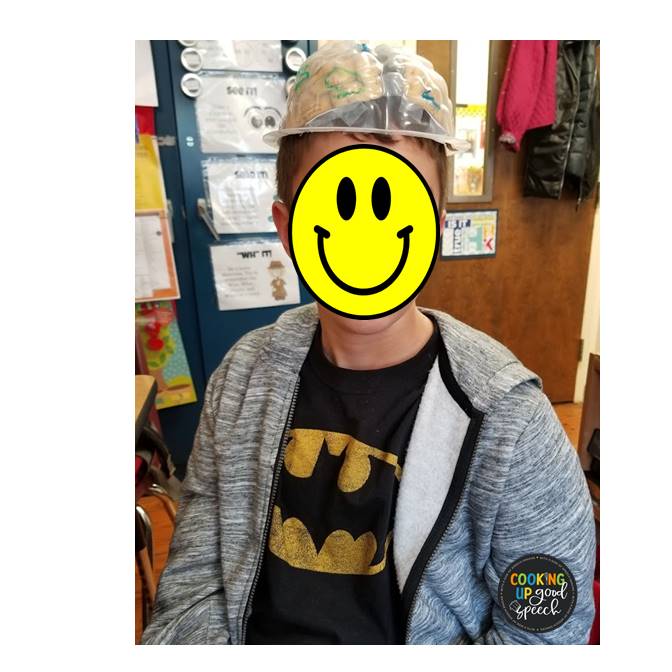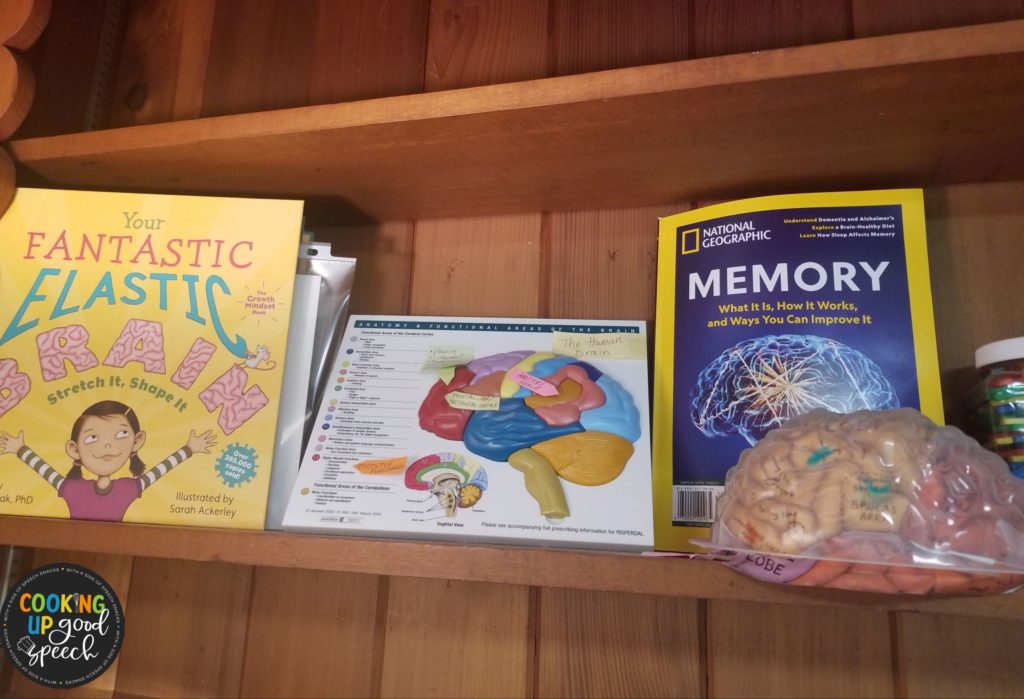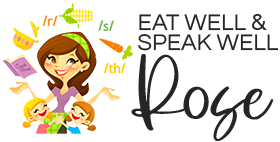
I spend A LOT of time working on executive functioning, growth mindset, and social skills with my older students. But before I can address the strategies that will help strengthen and improve these areas, I talk to them about their BRAIN! I like to do this at the beginning of the school year and make reference to this lesson as the year progresses. It is so important to give my students ALL the tools they need to help them understand the HOW and WHY before I can work on the skills. By giving them some background on how their brain works, they will gain a better understanding of their strengths and their weaknesses. Several years ago I stumbled upon this incredible resource. It’s a template of the human brain that clearly labels the lobes of the brain and what functions each area is responsible for. You can download your own free copy by visiting Ellen McHenry’s Basement Workshop. The download includes instructions for assembly and both color and black/white versions.

We put together a color copy of the”thinking cap” with a lot of careful cutting, folding, and taping. You can have your students color in each area on a black and white copy instead of printing a color copy to help get them familiar with the areas of the brain. I printed out a color copy that I taped to the inside of a clear plastic brain mold. You can find the brain mold in my Amazon Shop or during the fall/Halloween season, you might spot these in the dollar store.

Some of my students think it’s pretty funny to put on the “brain hat”/”thinking cap” and check themselves out in a mirror or take a selfie.

I focus on the prefrontal cortex when discussing the various areas of the brain hat with my students. The front part of the brain, the prefrontal cortex is the decision-making part of the brain, responsible for the ability to plan and think about the consequences of actions, solve problems, control impulses, make decisions, self-regulate (aka–our “executive functions.”). Changes in this part of the brain continue into early adulthood (around the mid-20’s). These are skills that, as SLPs, many of us address in our therapy sessions. Really when you think about it, executive functioning is interconnected with ALL of the communication goals we address with our students. It’s so important to teach my pre-teens and teenagers about how their brains are developing during this time in their life, as it answers so many WHY and HOW questions for them. (I like to add small sticky note strips to the brain with the labels: “plan, problem solve, self-control, decision making, self-regulation, organization, time management.” This will bring more attention to these EF skills on the brain model so your students can focus on their importance.
I tell them that because the prefrontal cortex is still “under construction”, teenagers might rely on a part of the brain called the amygdala (located in the temporal region) to make decisions and solve problems. The amygdala is associated with emotions, impulses, aggression, and instinctive behavior. The amygdala is not labeled on the brain hat, so I get a small post-it note and label it with “amygdala” and the words “emotions, impulses aggression, instincts” and place it in the temporal region as a visual reference for my students.
I like to use the “lost keys” analogy when explaining how the brain is working in the teen years: Imagine you have lost your car keys and you are already late for work. Think about how many times you look for the keys in the same place – 5, 10 even 20 times. You panic – you no longer think with your cortex, you are thinking with your emotions. Remember how it feels if someone tells you to calm down and think sensibly about when you last had them. That is how a teenager feels when they are running on their emotions because their brain hasn’t developed that linkage.

After we talk about the prefrontal cortex and amygdala, we focus on the areas of the brain that they feel are their greatest strengths and challenges. Using a GREEN and RED dry erase marker, I have my students highlight/color code the plastic brain model. In GREEN I have them highlight the areas that they feel are their STRENGTHS. In RED, they highlight the areas that present them with the greatest CHALLENGES in their daily lives. We focus primarily on the FRONTAL LOBE for this exercise since this is the headquarters for language and executive functions. (examples of areas labeled on the brain hat: sequencing, forming sentences, logic, decisions, naming things, analyzing, story ideas, creativity) The brain hat also labels the other lobes: temporal, parietal, occipital, sensory and motor cortex, cerebellum, as well as the functions of those regions, so your students can get a better understanding of the job of those areas of the brain.

Once they are done highlighting with the dry erase markers, we discuss their reasoning behind the red and green markings. We talk about why they feel certain areas are strengths and challenges for them, and give examples of these strengths and challenges. I help them make connections between their strengths/challenges and the communication goals in their IEPs, as well as to their performance in other subject areas. This is also an opportunity to address GROWTH MINDSET and let our students know that it’s okay to have some areas marked in red, as everyone has areas that they need to grow and improve and other areas that are strong. I share with them my own areas of strength (like creativity and decision making) and areas that are a challenge (like analyzing and math concepts!) I also remind them that as they grow and mature and practice the skills that are challenging, those red areas can eventually become green. Another way to improve the skills that are in red is to use STRATEGIES, and explain how important it is to practice the strategies that I give them in our speech and language sessions, as it will lead to progress. After we finish the activity with the brain hat, I ask my students to “brainstorm” (lol!) a list of their brain’s strengths and a list of their brain’s challenges. These can be academic strengths/challenges ( I am good at math/I have a hard time remembering new facts in science.), physical strengths/challenges (i.e. I am great at skateboarding/ I can’t do pushups), emotional strengths/challenges (I care about animals/ I get angry easily when I don’t know how to do my homework.) I praise them for their strengths and troubleshoot ways to change their challenges. We keep these lists in their speech folder and make reference to them mid-year and at the end of the year. I ask how they have changed/improved/grown since the beginning of the year? What areas still need more time to improve? What additional strengths/challenges would they add, since this list may change or grow as the year progresses.
I like to keep my brain hat on display in my therapy room, as many of my students are very inquisitive and like to pick it up and look it over, try it on for size, and talk about all the amazing things their brain is capable of doing.

I also have this book on display next to the brain hat. I love this book for explaining the anatomy and functions of the brain in easy-to-understand terms. It also addresses growth mindset and how making mistakes and exercising and stretching our brain is how it grows and develops. This book is probably most appropriate for elementary/middle school students, but I think even older students and adults can appreciate the key points presented.













Leave a Reply